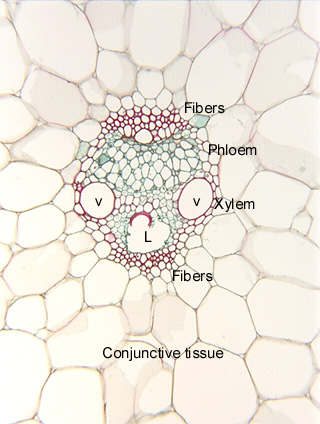 Fig.
11.5-5. Transverse section of corn stem (Zea mays). This
monocot vascular bundle shows several interesting and common features.
Fig.
11.5-5. Transverse section of corn stem (Zea mays). This
monocot vascular bundle shows several interesting and common features.
1)
The bundle sheath is very thin, only a single layer on the sides and just a few
fibers at the top and bottom of the bundle (the top would be the toward the
outside of the stem, the bottom of the micrograph is toward the center of the
stem). This vascular bundle was located near the center of the stem; those
nearer to the surface of the stem have thicker sheaths with more fibers.
2)
The phloem is an excellent example of the monocot type of phloem in which the
sieve tube members and companion cells form a regular pattern.
3) The two metaxylem vessels (marked by
“v”) are very large and prominent.
4) The protoxylem vessel has been torn because
the stem continued to elongate long after the vessel finished differentiation
and died; its primary wall and its secondary wall (which would have had either
an annular or helical pattern) were ripped apart creating a tubular space called
a lacuna (marked by “L”).